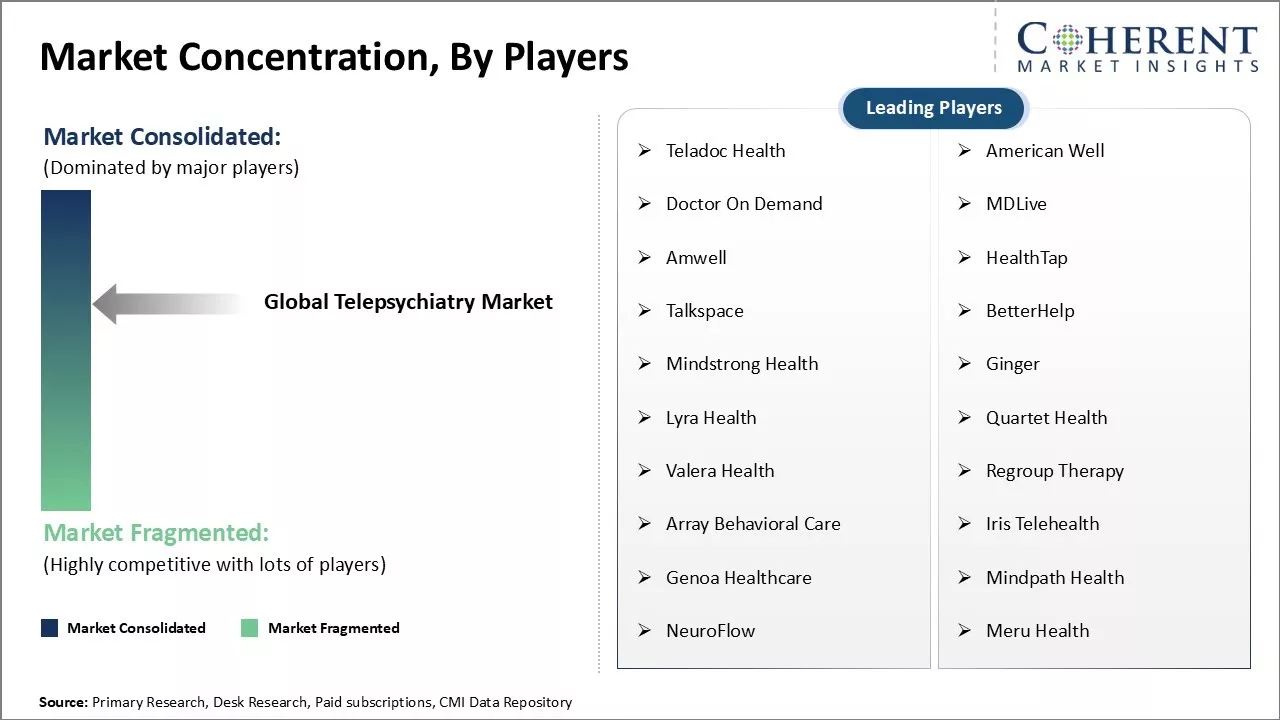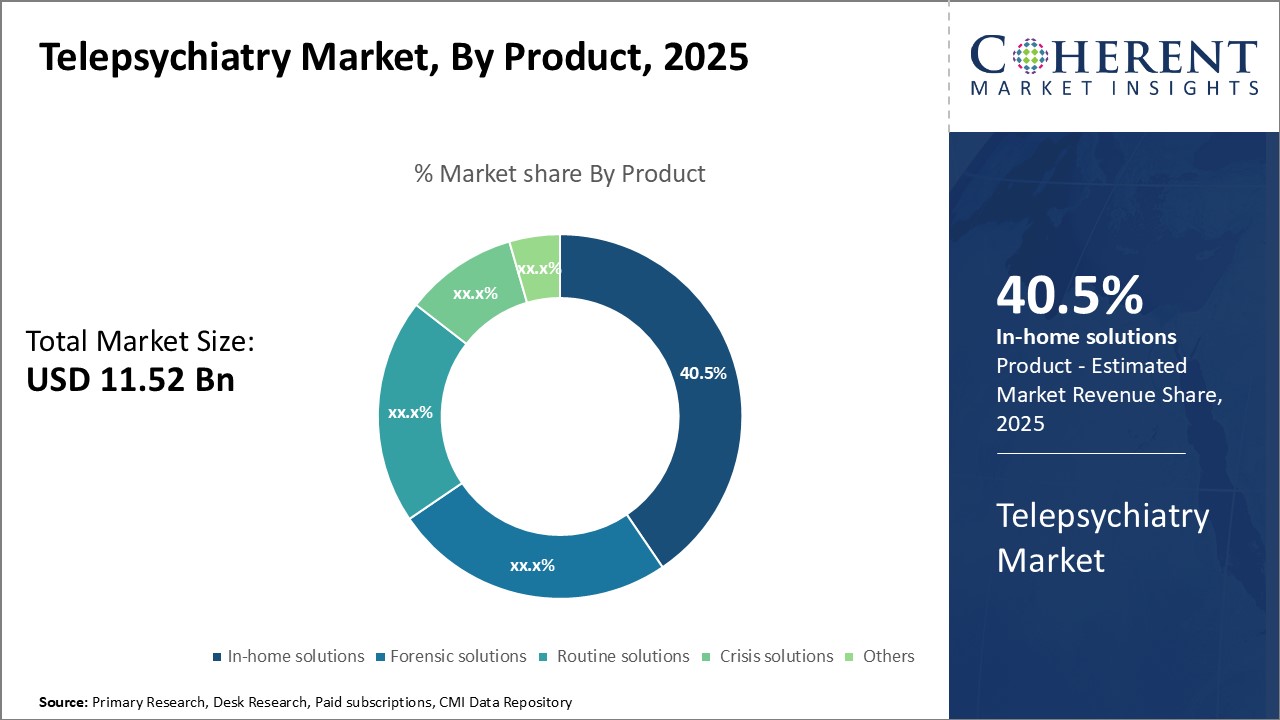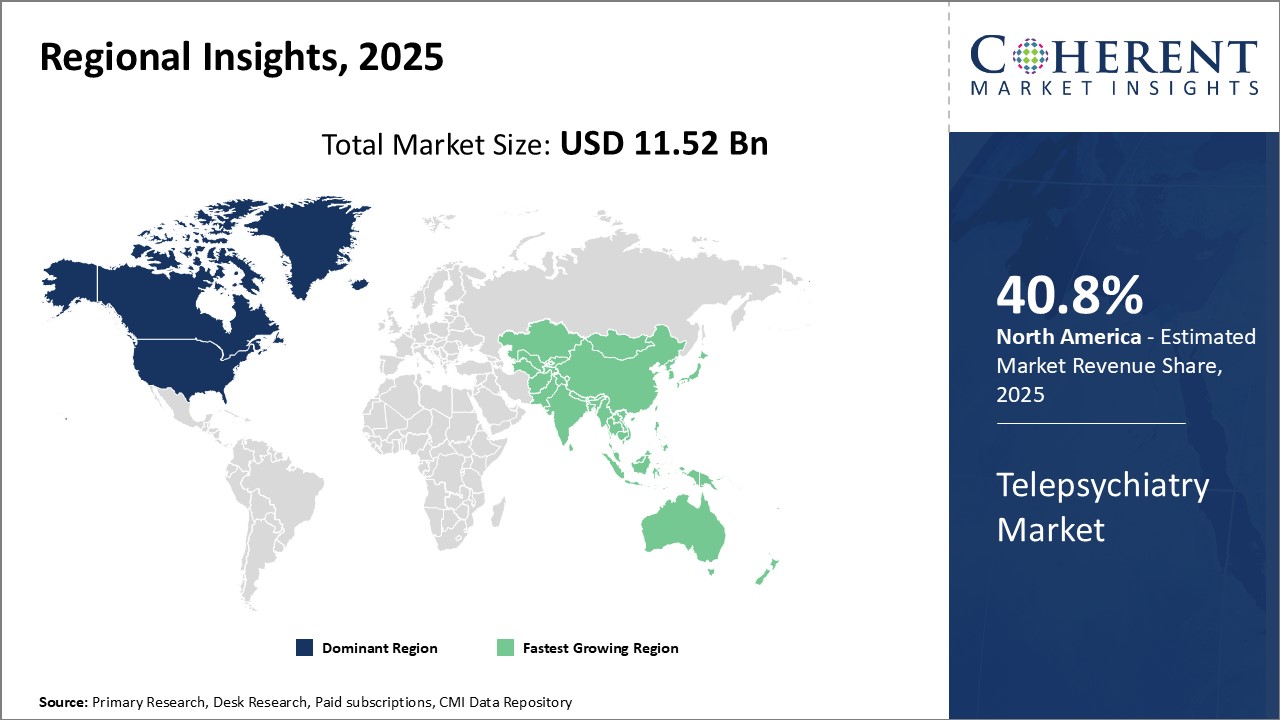Telepsychiatry Market Size and Trends
Global telepsychiatry market is estimated to be valued at USD 11.52 Bn in 2025 and is expected to reach USD 41.77 Bn by 2032, exhibiting a compound annual growth rate (CAGR) of 20% from 2025 to 2032.

Discover market dynamics shaping the industry: Download Free Sample
Increasing technological advancements such as smart devices, smartphones, tabs and computers along with easy availability of high-speed internet allowing remote delivery of mental health services can drive the market growth. Rising demand for cost-effective and convenient health services amid shortage of psychiatrists and long waiting time can boost adoption of telepsychiatry. Growing awareness regarding mental health issues and destigmatization boosts remote consultation through video or audio mediums. Supportive government policies and reimbursement for telehealth consultations can offer market growth opportunities in the future.
Shortage of Psychiatrists
Global shortage of psychiatrists can drive the market growth. The mental healthcare needs have been rising consistently but the number of trained psychiatrists has failed to keep pace. According to some estimates, has been severe lack of more than 250,000 psychiatrists all over the world. This shortage is more acute in developing and underdeveloped regions where the resources for mental healthcare are already meager. Even in developed countries with stronger healthcare infrastructure, the psychiatrist availability remains inadequate considering the current overall population and their needs.
This growing gap between demand and supply of psychiatric services and specialists has compelled healthcare systems and providers to explore new alternatives. The concept of telepsychiatry has emerged as an promising option that can help address this issue. By using advanced telecommunication technologies like video conferencing, telephonic consultations and other digital tools, psychiatrists can examine and interact with patients remotely. This allows them to evaluate and assist more number of people in lesser time without being physically present. Various telepsychiatry programs and services have started in different parts of the world to virtually connect patients in rural or underserved areas to specialist doctors in major cities and healthcare hubs. This boosts greater access to mental health support for communities that previously had poor or no psychiatrist availability.
Market Concentration and Competitive Landscape

Get actionable strategies to beat competition: Download Free Sample
Growing Acceptance of Telehealth Services
Telehealth technologies have witnessed improvements and widespread adoption in the mainstream healthcare industry. Patients and providers have embraced various virtual care options for their convenience. Concepts like telemedicine, remote patient monitoring and digital consultation have gained popularity. With changing attitudes, people have become more comfortable sharing personal health details through online video sessions or phone calls rather than always requiring in-person meetings. This growing acceptance of telehealth services boosts demand for telepsychiatry.Mental illness carries significant social stigma even today in many cultures and societies. The anonymity provided by virtual psychiatric consultations encourages more individuals to freely seek help and assessment of their condition without fear of being directly identified. This anonymity coupled with the avoided need to travel long distances for appointments has stronger appeal for many potential service users. As online therapy and tele-counselling options become widespread, people get more familiar with the model. Their confidence in the digital medium increases along with willingness to try it for psychological needs. The enhanced popularity of general telehealth approach increases acceptability of telepsychiatry services among communities.
Key Takeaways from Analyst:
Global telepsychiatry market growth is driven by increasing prevalence of mental health issues worldwide and limited access to psychiatrists and other mental healthcare professionals in many regions. Telepsychiatry helps address this issue by allowing patients to remotely access Emerging markets in developing countries present a huge opportunity for the global telepsychiatry market growth. These countries suffer from severe shortage of mental healthcare resources and specialists due to lack of infrastructure and workforce. Telepsychiatry can help address this issue by improving access and reducing disparities in mental healthcare provision. The lower costs associated with telehealth delivery also make telepsychiatry a sustainable model for these markets. Various telehealth initiatives by non-profit organizations in developing regions have already demonstrated telepsychiatry's potential. Rising awareness, investments in telecom infrastructure and task-sharing/e-learning programs training more providers can drive the market growth. International players need to offer localized solutions and comprehensive training to capitalize on this opportunity.

Discover high revenue pocket segments and roadmap to it: Download Free Sample
By Product - Dependence on Technology
In terms of product, in-home solutions segment is expected to contribute the highest market share of 40.5% in 2025, owing to increased dependence on advanced technologies. In-home solutions allow patients to access treatment virtually using technologies like video conferencing. This removes geographical barriers and makes treatment more convenient and accessible for those unable to visit clinics regularly. The ongoing pandemic has further accelerated digital adoption, highlighting the benefits of virtual healthcare models. With patients and doctors now more comfortable with telemedicine, there has been huge demand for in-home telepsychiatry solutions even post pandemic.
By Age Group- Prevalence among Working Adults
In terms of age group, adult segment is expected to contribute the highest market share of 38.5% in 2025, due to high prevalence of mental health issues among working professionals. Adults aged 18 years to 64 years constitute the most economically productive segment of society and undertake a majority of responsibilities. However, pressures of work, relationships and other daily stresses often lead to conditions like anxiety and depression. Telepsychiatry helps this age group balance medical needs with professional commitments by enabling consultations from the convenience of home or office. Given their time constraints, adults prefer virtual care options that are more flexible and less disruptive to schedules.
By End User- Rising Geriatric Population
In terms of end user, community mental health centers segment is expected to contribute the highest market share of 42.5% in 2025, owing to focus on outpatient care services. Community centers aim to shift treatment load from hospitals by providing closer-to-home services. This allows for early intervention and continuity of care. With growing geriatric population vulnerable to age-related psychological issues, telepsychiatry assists community centers in expanding their reach to serve the rising needs of the elderly people. Virtual consultations help address mobility limitations and make treatment more accessible for isolated seniors, especially those residing in remote or rural locations.
Regional Insights

Need a Different Region or Segment? Download Free Sample
North America dominates the global telepsychiatry market with an estimated market share of 40.8% in 2025. The widespread access and adoption of telehealth technologies among healthcare providers as well as patients have enabled seamless delivery of telepsychiatry services. Several leading telehealth software and platforms have also emerged from the region, making telepsychiatry services highly scalable. With growing awareness and acceptance of virtual care options, more patients can access mental health services from the comfort of their homes. The region also has a higher percentage of healthcare costs covered by insurance plans, which makes telepsychiatry a more affordable option for patients.
Asia Pacific has witnessed exponential growth in the telepsychiatry market and has emerged as the fastest growing regional market. Countries like India, China, Japan and Australia are dedicatedly working towards improving access to mental healthcare, especially in rural and underserved areas. Telepsychiatry plays a pivotal role in bridging the significant supply-demand gap for psychiatrists in the region. For example, India is training and deploying frontline health workers to utilize video counseling to screen patients for mental illnesses. Asian governments are also implementing favorable regulations and reimbursement policies to promote telehealth adoption. High-speed internet infrastructure development across Asia Pacific has empowered seamless delivery of telepsychiatry services. The large patient pools and growing mental health needs make Asia Pacific an attractive market for telepsychiatry stakeholders.
Market Report Scope
Telepsychiatry Market Report Coverage
| Report Coverage | Details | ||
|---|---|---|---|
| Base Year: | 2024 | Market Size in 2025: | USD 11.52 Bn |
| Historical Data for: | 2020 To 2024 | Forecast Period: | 2025 To 2032 |
| Forecast Period 2025 to 2032 CAGR: | 20.2% | 2032 Value Projection: | USD 41.77 Bn |
| Geographies covered: |
|
||
| Segments covered: |
|
||
| Companies covered: |
Teladoc Health, American Well, Doctor On Demand, MDLive, Amwell, HealthTap, Talkspace, BetterHelp, Mindstrong Health, Ginger, Lyra Health, Quartet Health, Valera Health, Regroup Therapy, Array Behavioral Care, Iris Telehealth, Genoa Healthcare, Mindpath Health, NeuroFlow, and Meru Health |
||
| Growth Drivers: |
|
||
| Restraints & Challenges: |
|
||
Uncover macros and micros vetted on 75+ parameters: Get instant access to report
Market Segmentation
- By Product Insights (Revenue, USD, 2020 - 2032)
- In-home solutions
- Forensic solutions
- Routine solutions
- Crisis solutions
- Others
- By Age Group Insights (Revenue, USD, 2020 - 2032)
- Adult
- Pediatric and Adolescent
- Geriatric
- By End User Insights (Revenue, USD, 2020 - 2032)
- Community Mental Health Centers
- Specialty Care Settings
- Skilled Nursing Facilities
- Homecare
- Others
- By Regional Insights (Revenue, USD, 2020 - 2032)
- North America
- U.S.
- Canada
- Latin America
- Brazil
- Argentina
- Mexico
- Rest of Latin America
- Europe
- Germany
- U.K.
- Spain
- France
- Italy
- Russia
- Rest of Europe
- Asia Pacific
- China
- India
- Japan
- Australia
- South Korea
- ASEAN
- Rest of Asia Pacific
- Middle East
- GCC Countries
- Israel
- Rest of Middle East
- Africa
- South Africa
- North Africa
- Central Africa
- North America
- Key Players Insights
- Teladoc Health
- American Well
- Doctor On Demand
- MDLive
- Amwell
- HealthTap
- Talkspace
- BetterHelp
- Mindstrong Health
- Ginger
- Lyra Health
- Quartet Health
- Valera Health
- Regroup Therapy
- Array Behavioral Care
- Iris Telehealth
- Genoa Healthcare
- Mindpath Health
- NeuroFlow
- Meru Health
Share
Share
About Author
Manisha Vibhute is a consultant with over 5 years of experience in market research and consulting. With a strong understanding of market dynamics, Manisha assists clients in developing effective market access strategies. She helps medical device companies navigate pricing, reimbursement, and regulatory pathways to ensure successful product launches.
Missing comfort of reading report in your local language? Find your preferred language :
Transform your Strategy with Exclusive Trending Reports :
Frequently Asked Questions
EXISTING CLIENTELE
Joining thousands of companies around the world committed to making the Excellent Business Solutions.
View All Our Clients
